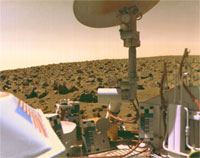 |
 |
|
|
 |
 |
 |
 |
|
|
 |
|
NASA's Marks 30th Anniversary of Mars Viking Mission
|
 |
July 14, 2006
 |

|
The boulder-strewn field of red rocks reaches to the horizon nearly two miles from Viking 2 on Mars' Utopian Plain. Image credit: NASA.
Full Res Image
|
|
 |
Thirty years after the first successful landing on Mars by NASA's Viking spacecraft, the ambitious mission continues to evoke pride and enthusiasm for future space exploration.
NASA's Viking 1 and 2 missions to Mars, each consisting of an orbiter and a lander, became the first space probes to obtain high resolution images of the Martian surface; characterize the structure and composition of the atmosphere and surface; and conduct on-the-spot biological tests for life on another planet.
Viking 1 was launched Aug. 20, 1975, and arrived at Mars on June 19, 1976. On July 20, 1976, the Viking 1 lander separated from the orbiter and touched down at Chryse Planitia. Viking 2 was launched Sept. 9, 1975, and entered Mars orbit Aug. 7, 1976. The Viking 2 lander touched down at Utopia Planitia on Sept. 3, 1976.
"The Viking team didn't know the Martian atmosphere very well, we had almost no idea about the terrain or the rocks, and yet we had the temerity to try to soft land on the surface," recalled Gentry Lee, Solar System Exploration chief engineer at NASA's Jet Propulsion Laboratory, Pasadena, Calif. Lee was the science analysis and mission planning director for the Viking mission. "We were both terrified and exhilarated. All of us exploded with joy and pride when we saw that we had indeed landed safely."
"The Viking mission looms like a legendary giant, an incredible success against which all present and future missions will be measured," said Doug McCuiston, Mars Exploration Program director at NASA Headquarters in Washington.
Originally designed to function for 90 days, the Viking spacecraft continued collecting data for more than six years. The landers accumulated 4,500 up-close images of the Martian surface. The accompanying orbiters provided more than 50,000 images, mapping 97 percent of the planet.
Viking provided the first measurements of the atmosphere and surface of Mars. These measurements are still being analyzed and interpreted. The data suggested early Mars was very different from the present day planet. Viking performed the first successful entry, descent and landing on Mars. Derivations of a Viking-style thermal protection system and parachute have been used on every U.S. Mars lander mission, including Mars Pathfinder and the Mars Exploration Rovers, Spirit and Opportunity.
NASA's Langley Research Center, Hampton, Va., managed the Viking Program. NASA’s Jet Propulsion Laboratory, managed by the California Institute of Technology in Pasadena, Calif., built the orbiters, provided the deep space network and managed the science mission. NASA's Glenn Research Center, Cleveland, designed the Titan/Centaur launch vehicles that propelled the spacecraft on their journey. NASA's Kennedy Space Center, Fla., provided the launch facility for the program. Scientists from across NASA served on the Viking science teams.
For more information about Viking, visit: http://www.nasa.gov/viking/ .
For information about NASA and agency programs, visit: http://www.nasa.gov/home/ .
###
Guy Webster 818-354-6278
Jet Propulsion Laboratory, Pasadena, California
Dwayne Brown/Erica Hupp 202-358-1726/1237
NASA Headquarters, Washington
Marny Skora 757-864-3315
Langley Research Center, Hampton, Va.
NEWS RELEASE: 2006-091
|
 |
 |
 |
|
 |
|
|